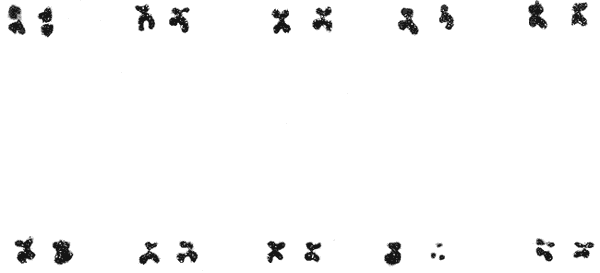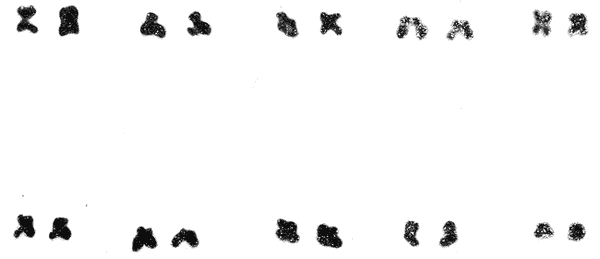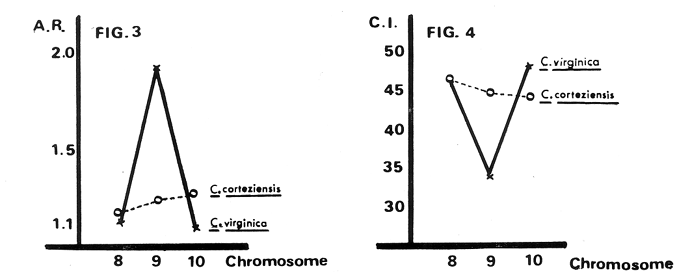|
COMPARATIVE ANALYSIS OF THE KARYOTYPES OF TWO OYSTER
SPECIES OF THE GENUS CRASSOSTREA FROM MEXICO: C. VIRGINICA AND C. CORTEZIENSIS
Trabajo presentado en el VI Congreso Nacional de Oceanografía,
Ensenada B. California México, 10 al 13 de abril, 1978. Recibido el 9 de
noviembre de 1977 y aceptado para su publicación el 28 de febrero de
1977.
FAUSTINO RODRÍGUEZ-ROMERO
ALFREDO LAGUARDA-FIGUERAS
MANUEL URIBE-ALCOCER
Universidad Nacional Autónoma de
México. Centro de Ciencias del Mar y Limnología.
Contribución 152 del Centro de Ciencias del Mar y Limnología,
UNAM.
Se compararon los cariotipos de Crassostrea
virginica y C. corteziensis. Los ejemplares fueron
obtenidos de las localidades de Tabasco y Nayarit, México,
respectivamente. Ambos cariotipos difieren sólo en dos aspectos: a) el
par de cromosomas número 9 es submetacéntrico en C.
virginica, mientras que en C. corteziensis es
metacéntrico. b) en el cariotipo de C.
virgínica se presenta una constricción secundaria y un
satélite cromosómico en el primer par; mientras que en
C. corteziensis no se presentan. Esas dos diferencias pueden
ser de utilidad en la discriminación de poblaciones de estas especies.
Desde el punto de vista citogenético, estas dos poblaciones de ostiones
pueden ser consideradas como razas cariotípicas.
Karyotypes of Crassostrea virginica
and C. corteziensis were compared. The specimens were
obtained from Tabasco and Nayarit, Mexico, respectively. Both differed only in
two aspects: a) while the chromosomic pair number 9 was submetacentric in C.
virginica, it was metacentric in C. corteziensis. b) a
secondary constriction and a chromosomic satellite were found in the first pair
of the karyotype of C. virginica, but not in C.
corteziensis. These two differences can be useful in the
discrimination of the populations of these species.
From the cytogenetic point of view, these two oyster
populations can be considered as karyotypic races.
Comparative chromosomic studies in related species have been of great value for the establishment of systematic relations of many animals and plants. However, in the invertebrates there is little cytogenetic information with the exception of insects. In Mollusca the literature on karyotype analysis is not abundant due to difficulties of obtaining mitotic fields with enough quality to carry out chromosomic studies; however, in the gasteropods and pelecypods some investigations to obtain the diploid number have been completed. Other karyotype characteristics have not been reported in most cases. (Burch, 1968; Menzel, 1968; Ahmed and Sparks, 1970; Patterson, 1973; Ieyama and Inaba, 1974). Longwell et al., (1967) studied the karyotype of Crassostrea virginica and reported some interesting chromosomic features such as secondary constrictions and satellites besides the diploid number and chromosome morphology. In that work, the authors recommended future cytogenetic studies on oysters to complement the knowledge of the chromosomic characteristics in these organisms. Crassostrea corteziensis has been studied with taxonomic purposes by Hertlein (1951) ; while ecological and taxonomical aspects have been analysed by Stuardo and Martinez (1975) and Castillo (1977). In view of the fact that both oyster species have been the object of taxonomic confussion, (Herlein 1951), a comparative karyotypic study on their chromosomic relationship was therefore undertaken. MATERIAL AND METHODSOyster specimens of Crassostrea virginica from Tabasco and Crassostrea corteziensis from Nayarit, Mexico were processed to obtain chromosomes by the air drying technique. A 0.01 % colchicine solution was used to stop mitotic metaphases (2 drops in 5 m1 of 2.2% sodium solution) one hour before contrifugation. A 1% sodium citrate hipotonic solution was used. The cells were fixed with Carnoy and slides were stained with giemsa and mounted in balsam. The chromosomes of the karyotype were statistically analysed and classified as by Levan et al. (1964) and Al-Aish (1969. Arm ratio and centromeric index of both karyotypes were compared. RESULTSCrassostrea virginica The diploid number observed was 20. All the chromosomes of the karyotype were biarmed (Fig. l). The pairs 1, 3, 6, 8 and 10 were classified as metacentrics, and the pairs 2, 4, 7 and 9 as submetacentrics (Table 1) . The arm number was 40. The presence of a secondary constriction was evident in the first pair of chromosomes in some of the mitotic fields analysed. These results were similar to those obtained by Longwell et al. (1967) in oyster populations from New Haven, Connecticut. Crassostrea corteziensis All the mitosis analysed showed 20 biarmed chromosomes (Fig. 2). The chromosomic size and shape of the elements of the karyotype showed slight differences between them and were classified as metacentrics, with the exception of the pairs 2, 4 and 7 which were submetacentrics (Table 1) . The arm number was, 40 chromosomic morphology and other features such as secondary constrictions and satellites were not identified.  Fig. 1. Chromosomes of Crassostrea virginica.  Fig. 2. Chromosomes of Crassostrea corteziensis.  TABLE 1 VALUES FOR ARM RATIO AND CENTROMERIC INDEX OF THE KARYOTYPES OF CRASSOSRTREA VIRGINICA Y C. CORTEZIENSIS. DISCUSSIONIn the genus Crassostrea populations are difficult to identify by external characters because shell morphology varies with the substrate and ecological peculiarities. Some non-cytogenetic characteristics that define the genus Crassostrea are oviparity and the promial camera. In a important cytotaxonomical study, Menzel (1968) demostrated that the diploid number and gross morphology of mitotic chromosomes of six species of Crassostrea were similar. However, other karyotype features were not described. Cytogenetic studies made by Longwell et al.(1967) in Crassostrea virginica showed in detail the fundamental morphological features of the mitotic and meiotic karyotypes. In that work the results obtained were similar to the karyotype of the oyster population we studied, in spite of differences in the technical procedures. The chromosomic analysis in Crassostrea corteziensis showed a great similarity to that of C. virginica. There were only two morphological differences of some cytogenetic importance: a) the presence of submetacentric chromosomes in pair 9 in the karyotype of C. virginica, while pair 9 was metacentric for C. corteziensis (Figs. 3 and 4) ; b) in the first pair of chromosomes of C. viginica a secondary constriction and a satellite were frequently observed. A common way of karyotypic evolution in the eukaryota is chromosomic inversion that permits morphological modifications in chromosomes. In the present study, the submetacentric chromosomes in the pair 9 of the karyotype of C. virginica could be explained by pericentric inversions if the primitive oyster karyotype of the ancestor had only metacentric chromosomes, as has been proposed (White, 1951). In this sense, the karyotype of C. corteziensis would be considered more primitive that of C. virginica. However, from this point of view these two species are closely related and must be capable of hibridization. However this remains to be proved in future experimental work.  Figs. 3 and 4. Arm Ratio (A. R.) and Centromeric Index (C. I.) of the cromosomic pairs 8, 9 and 10 of the karyotypes of Crassostrea virginica and C. corteziensis. The karyotypic small differences between the chromosomic sets of C. virginica and C. corteziensis show the adaptive changes at the cytological level produced by environmental differences in the geographical localities of these two species. These small. chromosomic differences are useful to discrimate oyster populations of the species studied. From the cytogenetic point view, these two species could be considered as karyotypic races. LITERATURAAHMED, M. and A. K. SPARKS Chromosome number, structure and autosomal polimorphism. in the marine mussels Mytilus edulis and Mytilis californianus. Biol. Bull. 1970 1-13 1 138 AL-AISH, M. S. Human chromosome morphology. 1. Studies on normal chromosome characterization classification and karyotyping Can. J. Genet. Cytol. 1969 370-381 11 BURCH, J. B. A tissue culture technique for karyotype analyses of pulmonate land snails Venus Jap. J. Malacol. 1968 20-27 1 27 CASTILLO, Z. G. Contribución al estudio taxonómico de algunas especies mexicanas de la familia Ostreidae Tesis profesional Fac. Ciencias Univ. Nal. Autón. México 1977 108 p. HERTLEIN, L. G. Descriptions of two new species of marine pelecypods from west Mexico Bull. Cal. Acad. Sci. 1951 68-75 part 2 50 IEYAMA, H. and A. INABA Chromosome numbers of ten species in four families of Pterimorphia (Bivalvia). Venus, Jap. Malacol. 1974 134 4 32 KAWAI, M. Chromosomes of two species of shore chitons from Japan. Venus. Jap. Malacol. 1976 143-146 3 35 LEVAN, A. K. FREDGA and A. A. SANDBERG Nomenclature for centromeric position on chromosomes. Hereditas 1964 201-220 52 LONGWELL, A. C., S. S. STILES and D. G. SMITH Chromosomes complement of the american oyster Crassostrea virginica, as seen in meiotic and cleaving egos Can J. Genet. Cytol. 1967 854-856 9 MENSEL. R. W. Cytotaxonomy of clams (Mercenaria) and oysters (Crassostrea) Proc. Symp. Moll. 1968 75-87 part 1 PATTERSON, C. M. Symposium on genetics, cytogenetics and hybridization of marine mollusks. Bull. Am. Malacol. Un. Inc. 1973 34-35 STUARDO, J. y A. MARTÍNEZ Relaciones entre algunos factores ecológicos y la biología de poblaciones de Crassostrea corteziensis Hertlein 1951, de San Blas, Nayarit, México An. Centro Cienc. del Mar y Limnol. Univ. Nal. Autón. México 1975 89-129 1 2 WHITE, M. J. D. Citología Animal y Evolución. Espasa-Calpe Argentina, S. A. México 1951 511 p.
|

